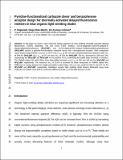Pyridine-functionalized carbazole donor and benzophenone acceptor design for thermally activated delayed fluorescence emitters in blue organic light emitting diodes
Date
05/03/2018Grant ID
EP/P010482/1
RPG-2016-047
749557
EP/P010482/1
Keywords
Metadata
Show full item recordAbstract
In this paper we report a new molecular design approach for blue emitting thermally activated delayed fluorescence (TADF) molecules. The two novel TADF emitters, (4-(3,6-di(pyridin-3-yl)-9H-carbazol-9- yl)phenyl)(phenyl)methanone ( 3PyCzBP ), and (4-(3,6-diphenyl-9H-carbazol-9-yl)phenyl)(phenyl)methanone ( 4PyCzBP ) possess a pyridine-functionalized carbazole donor and a benzophenone acceptor. Both compounds shows broad charge-transfer emission in DCM with a λmax at 497 nm and a photoluminescence quantum yield, ΦPL of 56% for 3PyCzBP and a λmax at 477 nm and a ΦPL of 52% for 4PyCzBP . The ΦPL decreased to 18% and 10%, respectively for 3PyCzBP and 4PyCzBP in the presence of O2 confirming that triplet states involved in emission. The PMMA doped (10 wt%) films show blue-shifted emission with λmax at 450 and 449 nm for 3PyCzBP and 4PyCzBP , respectively. The maximum ΦPL of 23.4% is achieved for these compounds in PMMA doped film. Difference in energy between the singlet and triplet excited states (ΔEST) is very small at 0.06 eV and 0.07 eV for 3PyCzBP and 4PyCzBP , respectively. Multilayer organic light emitting diode devices fabricated using these molecules as emitters show that the maximum efficiency (EQEmax) of the blue devices is 5.0%.
Citation
Pachai Gounder , R , Rota Martir , D & Zysman-Colman , E 2018 , ' Pyridine-functionalized carbazole donor and benzophenone acceptor design for thermally activated delayed fluorescence emitters in blue organic light emitting diodes ' , Journal of Photonics for Energy , vol. 8 , no. 3 , 032106 . https://doi.org/10.1117/1.JPE.8.032106
Publication
Journal of Photonics for Energy
Status
Peer reviewed
ISSN
1947-7988Type
Journal article
Description
The authors thank the Marie Skłodowska-Curie Individual Fellowship (MCIF, no 749557), the Leverhulme Trust (RPG-2016-047) and EPSRC (EP/P010482/1) for financial support.Collections
Items in the St Andrews Research Repository are protected by copyright, with all rights reserved, unless otherwise indicated.

